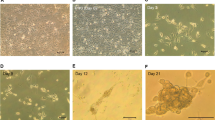Abstract
THERE has been much speculation on the possible hazards of hybrid DNA technology1. An important question in this context is whether a viral DNA, covalently linked to a vector, can be transferred from within a bacterium into an animal cell, either in vitro or in vivo, and initiate viral infection. As a first step, it is necessary to determine whether a hybrid containing eukaryotic viral DNA can, on penetration into a permisive cell, give rise to virus formation, as is the case for hybrids containing a prokaryotic viral sequence2. As part of a risk-testing programme sponsored by EMBO, this question was investigated with mouse polyoma virus DNA. Polyoma virus will grow readily in mice; infection can be initiated by a single infectious particle as well as by naked viral DNA, and can be easily detected by monitoring the production of anti-viral antibodies. Virus production, and not tumour formation, was chosen as a criterion for biological activity because although polyoma virus will transform cells in vitro, tumours are produced in vivo only when large quantities of virus are inoculated into immunologically immature or immunosuppressed animals. We describe here the construction and characterisation of various plasmid pBR322 and phage λ derivatives containing polyoma DNA and their infectivity towards mouse fibroblast cells. The only recombinant molecules so far obtained which were infective as intact molecules were plasmids with dimeric polyoma DNA inserts.
This is a preview of subscription content, access via your institution
Access options
Subscribe to this journal
Receive 51 print issues and online access
$199.00 per year
only $3.90 per issue
Buy this article
- Purchase on Springer Link
- Instant access to full article PDF
Prices may be subject to local taxes which are calculated during checkout
Similar content being viewed by others
References
King, J. Nature 276, 4–7 (1978).
Taniguchi, T., Palmieri, M. & Weissmann, C. Nature 274, 223–228 (1978).
Miller, L. K., Cooke, B. E. & Fried, M. Proc. natn. Acad. Sci. U.S.A. 73, 3073–3077 (1976).
Grunstein, M. & Hogness, D. S. Proc. natn. Acad. Sci. U.S.A. 72, 3961–3965 (1975).
Hohn, B. & Murray, K. Proc. natn. Acad. Sci. U.S.A. 74, 3259–3263 (1977).
Murray, N. E., Brammar, W. J. & Murray, K. Molec. gen. Genet. 150, 53–61 (1977).
Benton, W. D. & Davis, R. W. Science 196, 180–182 (1977).
Murray, N. E. & Murray, K. Nature 251, 476–481 (1974).
Emmons, S. W., MacCosham, V. & Baldwin, R. L. J. molec. Biol. 91, 133–146 (1975).
Fried, M. J. Virol. 13, 939–946 (1974).
Southern, E. M. J. molec. Biol. 98, 503–517 (1975).
Jaenisch, R. & Levine, A. Virology 44, 480–493 (1971).
Israel, M. A., Byrne, J. C. & Martin, M. A. Virology 87, 239–246 (1978).
Kaiser, A. D. & Hogness, D. S. J. molec. Biol. 2, 392–415 (1960).
Mandel, M. & Higa, A. J. molec. Biol. 53, 159–162 (1970).
Lederberg, E. M. & Cohen, S. N. J. Bact. 119, 1072–1074 (1974).
Fried, M. & Griffen, B. E. Adv. Cancer Res. 24, 63–113 (1977).
Katz, L., Kingsbury, D. T. & Helinski, D. R. J. Bact. 114, 577–591 (1973).
Currier, T. C. & Nester, E. W. Analyt. Biochem. 76, 431–441 (1976).
Thomas, M. & Davis, R. W. J. molec. Biol. 91, 315–328 (1975).
Blin, N., Gabain, A. V. & Bujard, H. FEBS Lett. 53, 84–86 (1975).
Murray, K. & Murray, N. E. J. molec. Biol. 98, 551–564 (1975).
Wilson, G. G. & Murray, N. E. J. molec. Biol. (in the press).
Kelly, T. J., Lewis, A. M., Levine, A. S. & Siegel, S. J. molec. Biol. 89, 113–126 (1974).
Chan, H. W., Israel, M. A. Rowe, W. P. & Martin, M. A. Science 203, 883–887 (1979).
Chan, H. W., Israel, M. A., Garon, C. F., Rowe, W. P. & Martin, M. A. Science 203, 887–892 (1979).
Author information
Authors and Affiliations
Rights and permissions
About this article
Cite this article
FRIED, M., KLEIN, B., MURRAY, K. et al. Infectivity in mouse fibroblasts of polyoma DNA integrated into plasmid pBR322 or lambdoid phage DNA. Nature 279, 811–816 (1979). https://doi.org/10.1038/279811a0
Received:
Accepted:
Issue Date:
DOI: https://doi.org/10.1038/279811a0
Comments
By submitting a comment you agree to abide by our Terms and Community Guidelines. If you find something abusive or that does not comply with our terms or guidelines please flag it as inappropriate.



